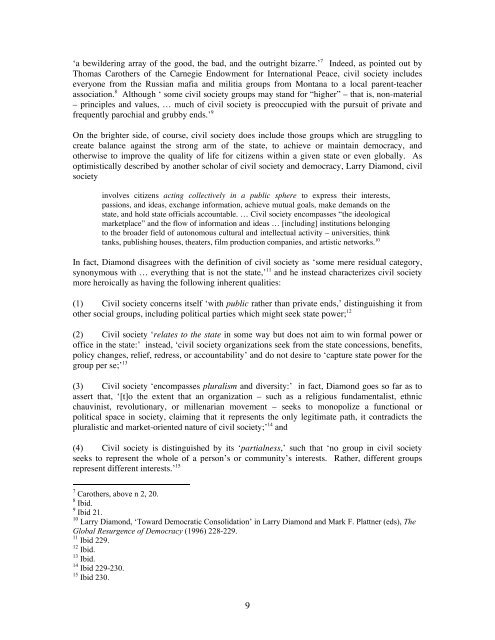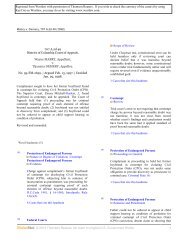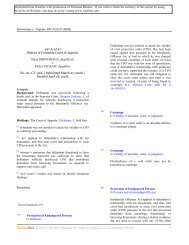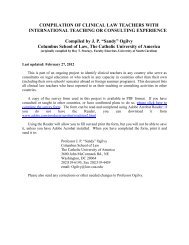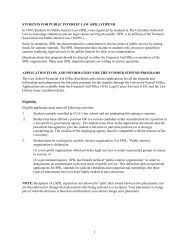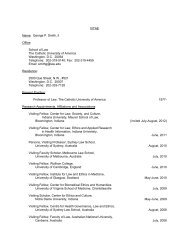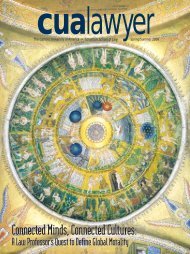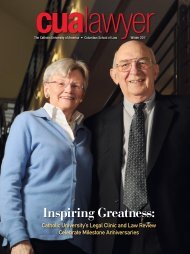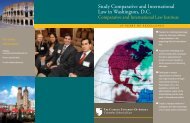a dynamic part <strong>of</strong> civil society -- and particularly as historically promoted by one such institution,the Islamic trust or waqf -- is the primary focus <strong>of</strong> this article. Indeed, the waqf (pl. awqaf) hasbeen for many centuries a mainstay component <strong>of</strong> civil society in Muslim countries. Today,awqaf are enjoying a resurgence in Muslim society, both in the traditionally Muslim countries <strong>of</strong>the Middle East and in the Muslim-dominated countries <strong>of</strong> Asia. In these countries, the stateexpressly permits the establishment <strong>of</strong> awqaf through various enabling legislation, although italso strictly regulates and administers the creation and management <strong>of</strong> awqaf through diversebureaucratic vehicles such as government waqf administrators and boards. As an illustration <strong>of</strong>such strict bureaucratic regulation, the regulatory framework in Pakistan is reviewed generally inthis article. It is suggested that especially in Pakistan -- where issues <strong>of</strong> control (and <strong>of</strong>ten cooption)by the government <strong>of</strong> various actors in civil society, as well as corruption and lack <strong>of</strong>transparency within the civil society institutions themselves, are predominant concerns -- thewaqf is inherently an institution which can allay many <strong>of</strong> these concerns and, at the same time,may provide a further dividend well-beyond mere temporal concerns.<strong>II</strong>.C<strong>IV</strong>IL SOCIETY IN ASIA: DEFINITION AND CONCEPTSCivil society in Asia, as well as in the rest <strong>of</strong> the world, is not easily susceptible <strong>of</strong> definition. Itis a concept which has changed in meaning from earliest discussions by Cicero and other Romanand Greek philosophers (who, perhaps ironically, used the term to refer to the state andcivilization based on rule <strong>of</strong> law); through modernization <strong>of</strong> the concept by Thomas Paine andGeorg Hegel as a ‘domain parallel to but separate from the state’; 2 and then more recentlythrough the writings <strong>of</strong> Karl Marx (who saw civil society as ‘crass materialism’ emerging out <strong>of</strong>capitalism 3 ) and neo-Marxist theorist Antonio Gramsci, who championed civil society as therealm <strong>of</strong> independent and autonomous political association, holding in check the tyranny <strong>of</strong> thestate. 4 As various scholars struggle to define it, ‘the term “civil society” is an evolving and <strong>of</strong>tencontested construct whose meaning has varied in different times and places. 5One <strong>of</strong> the simplest (and perhaps most <strong>of</strong>ten-quoted) contemporary definitions <strong>of</strong> ‘somethingcalled civil society’ was succinctly stated by the late philosopher/sociologist Ernst Gellner in one<strong>of</strong> the Tanner Lectures on Human Values at Harvard in 1990: ‘Civil society, in the relevantsense, is first <strong>of</strong> all that part <strong>of</strong> society which is not the state. It is a residue.’ 6 That perhaps vaguedefinition, while at first blush seemingly over-broad and too all-inclusive, is in actuality quiteaccurate. Civil society, as that term is used in contemporary political philosophy, subsumesvirtually all aspects <strong>of</strong> society in our world today, except for the state itself. Although ‘some civilsociety enthusiasts have propagated the misleading notion that civil society consists only <strong>of</strong> noblecauses and earnest, well-intentioned actors,’ civil society also has been characterized colorfully asliterature, as well as in common parlance, regarding the meaning <strong>of</strong> ‘philanthropy’ and ‘charity.’ Manysources quoted in this paper use the terms interchangeably, and every effort will be made to clarify theusage in the relevant context.2 Thomas Carothers, ‘Civil Society’ [Winter 1999-2000] Foreign Policy 18, 19.3 See, generally, Ishtiaq Ahmed, ‘Civil Society and South Asia’, Daily Times (Pakistan), 25 August 2002, at 29 June 2005.4 Not too surprising, given that Gramsci was miserably persecuted by the state, ultimately dying in prisonsolitude. See, generally, Antonio Gramsci, Selections from the Prison Notebooks (Quinton Hoare andGe<strong>of</strong>frey Nowell Smith, eds and trans, 1971) [trans <strong>of</strong> selected texts from Quaderni del carcere].5 Errol E. Meidinger, ‘Environmental <strong>Law</strong>: Forest Certification’ (2001) 10 Buffalo Environmental <strong>Law</strong>Journal 211, 226.6 Andre Ernst Gellner, ‘The Civil and the Sacred,’ (Speech delivered at the Tanner Lectures on HumanValues, Harvard University, 20-21 March 1990) , at 07 July 2005.8
‘a bewildering array <strong>of</strong> the good, the bad, and the outright bizarre.’ 7 Indeed, as pointed out byThomas Carothers <strong>of</strong> the Carnegie Endowment for International Peace, civil society includeseveryone from the Russian mafia and militia groups from Montana to a local parent-teacherassociation. 8 Although ‘ some civil society groups may stand for “higher” – that is, non-material– principles and values, … much <strong>of</strong> civil society is preoccupied with the pursuit <strong>of</strong> private andfrequently parochial and grubby ends.’ 9On the brighter side, <strong>of</strong> course, civil society does include those groups which are struggling tocreate balance against the strong arm <strong>of</strong> the state, to achieve or maintain democracy, andotherwise to improve the quality <strong>of</strong> life for citizens within a given state or even globally. Asoptimistically described by another scholar <strong>of</strong> civil society and democracy, Larry Diamond, civilsocietyinvolves citizens acting collectively in a public sphere to express their interests,passions, and ideas, exchange information, achieve mutual goals, make demands on thestate, and hold state <strong>of</strong>ficials accountable. … Civil society encompasses “the ideologicalmarketplace” and the flow <strong>of</strong> information and ideas … [including] institutions belongingto the broader field <strong>of</strong> autonomous cultural and intellectual activity – universities, thinktanks, publishing houses, theaters, film production companies, and artistic networks. 10In fact, Diamond disagrees with the definition <strong>of</strong> civil society as ‘some mere residual category,synonymous with … everything that is not the state,’ 11 and he instead characterizes civil societymore heroically as having the following inherent qualities:(1) Civil society concerns itself ‘with public rather than private ends,’ distinguishing it fromother social groups, including political parties which might seek state power; 12(2) Civil society ‘relates to the state in some way but does not aim to win formal power or<strong>of</strong>fice in the state:’ instead, ‘civil society organizations seek from the state concessions, benefits,policy changes, relief, redress, or accountability’ and do not desire to ‘capture state power for thegroup per se;’ 13(3) Civil society ‘encompasses pluralism and diversity:’ in fact, Diamond goes so far as toassert that, ‘[t]o the extent that an organization – such as a religious fundamentalist, ethnicchauvinist, revolutionary, or millenarian movement – seeks to monopolize a functional orpolitical space in society, claiming that it represents the only legitimate path, it contradicts thepluralistic and market-oriented nature <strong>of</strong> civil society;’ 14 and(4) Civil society is distinguished by its ‘partialness,’ such that ‘no group in civil societyseeks to represent the whole <strong>of</strong> a person’s or community’s interests. Rather, different groupsrepresent different interests.’ 157 Carothers, above n 2, 20.8 Ibid.9 Ibid 21.10 Larry Diamond, ‘Toward Democratic Consolidation’ in Larry Diamond and Mark F. Plattner (eds), TheGlobal Resurgence <strong>of</strong> Democracy (1996) 228-229.11 Ibid 229.12 Ibid.13 Ibid.14 Ibid 229-230.15 Ibid 230.9
- Page 1 and 2: INTERNATIONAL JOURNAL OF CIVIL SOCI
- Page 3 and 4: Letter from the EditorDear Readers,
- Page 5 and 6: TABLE OF CONTENTSIJCSL EDITORIAL BO
- Page 7: ARTICLESTHE ROLE OF THE ISLAMIC WAQ
- Page 11 and 12: [a]lthough civil society organizati
- Page 13 and 14: to integrate economic development a
- Page 15 and 16: duty.’ 55 In contrast to zakāt,
- Page 17 and 18: of such venerable educational insti
- Page 19 and 20: avoiding the appearance of impiety,
- Page 21 and 22: …’ 101 Throughout the Islamic w
- Page 23 and 24: partisan judiciary, a vigilant pres
- Page 25 and 26: number of awqaf for myriad public p
- Page 27 and 28: made over to the plundering hands o
- Page 29 and 30: prescribed by law. 159 Like the 192
- Page 31 and 32: property is not a waqf property or
- Page 33 and 34: VIII. REFERENCESA. Articles/BooksAh
- Page 35 and 36: Meidinger, Errol E, ‘Environmenta
- Page 37 and 38: STUDENT ARTICLESINTERNATIONAL INSTR
- Page 39 and 40: interest for the Balkan, minorities
- Page 41 and 42: dimension is emphasized with Articl
- Page 43 and 44: The Copenhagen document deals with
- Page 45 and 46: Historically, the 1946 Constitution
- Page 47 and 48: service, or sometimes 239 special f
- Page 49 and 50: This position by the Greek governme
- Page 51 and 52: a member of the civil state, entitl
- Page 53 and 54: Civilization" with headquarters in
- Page 55 and 56: term "vinozhito"(rainbow) could pos
- Page 57 and 58: declare the party as unconstitution
- Page 59 and 60:
The cases analyzed below, exemplify
- Page 61 and 62:
ECHR, and based upon this analysis,
- Page 63 and 64:
Jabuka in particular, recognized as
- Page 65 and 66:
the minority still face problems in
- Page 67 and 68:
BibliographyBooks:BLACK’S LAW DIC
- Page 69 and 70:
Vlassis Vlassidis, Veniamin Karakos
- Page 71 and 72:
THE DIFFERING TAX TREATMENT OF INVE
- Page 73 and 74:
…any person who, for compensation
- Page 75 and 76:
the assets under management. 437 Th
- Page 77 and 78:
As a preliminary matter, a taxpayer
- Page 79 and 80:
Commissioner further summarized the
- Page 81 and 82:
number of itemized returns. These t
- Page 83 and 84:
fiduciary duty implications applica
- Page 85 and 86:
operate as a fraud or deceit upon t
- Page 87 and 88:
Policy ConsiderationsIn light of th
- Page 89 and 90:
more advantageous to address altern
- Page 91 and 92:
STUDENT NOTESBUILDING CONSUMER CAPA
- Page 93 and 94:
CASE NOTESC A N A D I A N S U P R E
- Page 95 and 96:
minimum constitutional protection t
- Page 97 and 98:
objective of ensuring safety in sch
- Page 99 and 100:
Turning to its impact on courts and
- Page 101:
tribunals to ensure that an appropr


